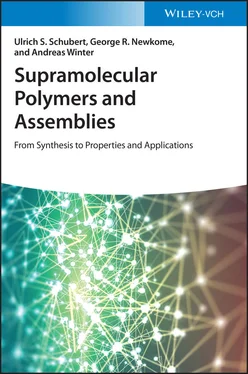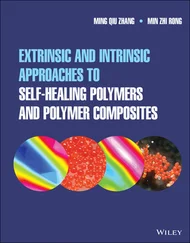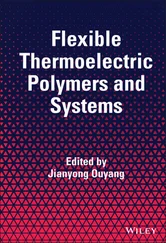6 Chapter 6Figure 6.1 Schematic representation of important crown ether hosts.Figure 6.2 Schematic representation of the (pseudo)rotaxane formation. Source: Zheng et al. [9], 2012 Royal Society of Chemistry.Figure 6.3 (a) Schematic representation of the AB‐type monomer 4and the ball‐stick representation of the solid structure of the dimer ( 4) 2(counter ions were omitted for clarity). (b) MALDI time‐of‐flight mass spectrum of 4. Source: Cantrill et al. [35], © 2001 American Chemical Society.Figure 6.4 (a) Schematic representation of monomer 5. (b): Space‐filling representation of the [ c 2]daisy chain ( 5) 2(counterions were omitted for clarity). Source: Ashton et al. [38], © 1998 John Wiley and Sons.Figure 6.5 (a) Schematic representation of the self‐assembly of 6into a polypseudorotaxane. (b) Schematic representation of the multifunctional monomer 7.Figure 6.6 (a) Schematic representation of the formation of a supramolecular polymer gel via the self‐assembly of a flexible AB‐type monomer. (b) Pictures of the supramolecular gel and its stimuli‐triggered gel–sol transitions (by changing either the temperature or pH value). Source: Dong et al. [41]. Figure reproduced with kind permission; © 2011 Wiley‐VCH.Figure 6.7 Schematic representation of the photoinduced supramolecular polymerization of 8which was accompanied by sol–gel transition of the solution at high monomer concentrations. Source: Zheng et al. [43]. Figure reproduced with kind permission; © 2018 Elsevier B.V.Figure 6.8 Schematic representation of the self‐assembly of the complementary homoditopic monomers 9and 10(a) as well as 11and 12(b); the counterions were omitted for clarity [47]. Source: Figure reproduced with kind permission; © 2003 American Chemical Society.Figure 6.9 Schematic representation of polypseudorotaxane formation via selective crown ether recognition. Source: Wang et al. [49], © 2009 Royal Society of Chemistry.Figure 6.10 Schematic representation of the supramolecular self‐assembly of 15and 12( m = 10). The supramolecular polymer exhibited AIE‐based fluorescence in solution as well as in the solid state, i.e. in the electrospun nanofibers. Two representative SEM images (a/b) an a fluorescence microscopy image (c) of the fibers are shown. Source: Chen et al. [50], © 2015 The Royal Chemical Society.Figure 6.11 Schematic representation of the multifunctional monomer 16and its transformation into a linear supramolecular polymer (poly‐ 16), covalent (co)polymers ( 17) and, eventually, covalent‐supramolecular polymers. A summary of the mechanical properties of these materials is also depicted. Source: Zhang et al. [51], © 2020 John Wiley and Sons.Figure 6.12 Schematic representation of the hetero‐tetratopic monomer 18,which gave a supramolecular polymer network due to a self‐cross‐linking process. Source: Wang et al. [52]. Figure reproduced with kind permission; © 2020 American Chemical Society.Figure 6.13 (a) Schematic representation of the formation of a host–guest assembly via threading MV 2+into the cavity of cryptand 19. (b) Schematic representation of the self‐assembly of AA‐type monomers with the BB‐type (MV 2+) 2‐monomer into linear supramolecular polymers. Source: Niu et al. [57], © 2011 American Chemical Society.Figure 6.14 Schematic representation of the formation of a cryptand‐based linear supramolecular polymer via three different reaction pathways. Source: Wei et al. [60].Figure 6.15 (a) Schematic representation of the unsymmetrical cryptand 20. (b) Schematic representation of the host–guest complex of 20with the MV 2+and dibenzylammonium cation. (c) Schematic representation of the linear supramolecular polymer assembled from 20and the ditopic guests 12and 14. Source: Yao et al. [61], © 2018 John Wiley and Sons.Figure 6.16 Schematic representation of macromolecular building blocks for host–guest complexation, based on crown ether recognition. Source: Zheng et al. [9], © 2012 Royal Society of Chemistry.Figure 6.17 (a) Schematic representation of the (a) polymer chain extension via crown ether recognition. Source: Based on Gibson et al. [63]Figure 6.18 Schematic representation of the heteroditopic macromonomers 21. The nanofibers, fabricated from the chain‐extended polymer ( 21) nby electrospinning, showed a multiple degradation behavior. The representative SEM images show the fibers before (c) and after the respective treatment with K +(a), NEt 3(b), Cl −(d), and heat (e). Source: Chen et al. [123]. Figure reproduced with kind permission; © 2016 The Royal Chemical Society.Figure 6.19 Schematic representation of the self‐assembly of the AB 2‐monomer 22into a supramolecular hyperbranched polymer.Figure 6.20 Schematic representation of the formation of dendritic pseudorotaxanes via a convergent synthesis. Source: Gibson et al. [72], © 2002 American Chemical Society.Figure 6.21 Schematic representation of the formation of star‐shaped and graft polymers (a and b, respectively), based on crown ether recognition. Source: (a) Zheng et al. [9], © 2012 Royal Society of Chemistry; (b) Gibson et al. [75], © 2009 John Wiley and Sons.Figure 6.22 Schematic representation of the formation of dendrimers, based on crown ether recognition: (a) threading‐followed‐by‐stoppering and subsequent Wittig exchange. and (b) sliding methodology. Source: Elizarov et al. [80], © 2002 American Chemical Society.Figure 6.23 Schematic representation of the formation of a [2]rotaxane via a thermal azide to alkyne cycloaddition “click” reaction. Source: Ashton et al. [82], © 1996 John Wiley and Sons.Figure 6.24 (a) Schematic representation of the so‐called Wittig exchange – transformation of the “reactive” rotaxane Iinto the “inert” rotaxane IIIvia intermediate II. Source: Rowan et al. [76], © 2000 American Chemical SocietyFigure 6.25 Schematic representation of the formation of a mechanically interlocked daisy chain using the Wittig exchange (a) and the “threading‐followed‐by‐swelling” methodology. Source: Rowan et al. [76], © 2000 American Chemical SocietyFigure 6.26 Schematic representation of a supramolecular muscle/shuttle, based on the pH‐switchable [ c 2]daisy chain ( 28) 2. Source: Coutrot et al. [88], © 2008 American Chemical Society .Figure 6.27 Schematic representation of building block 23and the derived poly([ c 2]daisy chain) that was utilized for expansion/contraction studies. Source: Clark et al. [93], © 2009 American Chemical Society.Figure 6.28 (a) Schematic representation of the synthesis of a poly[2]rotaxane via Sonogashira cross‐coupling polymerization. Source: Sasabe et al. [94]Figure 6.29 Schematic representation of the synthesis of dendritic [4]rotaxanes by “dynamic covalent chemistry” (DCC). Source: Leung et al. [99], © 2005 American Chemical Society.Figure 6.30 Schematic representation of main‐chain pseudorotaxane formation via two different synthetic strategies: Multiple threading of macrocycles onto a linear polymer chain (top) and polymerization of preassembled pseudorotaxanes, as supramonomers (bottom). Source: Wenz et al. [101], © 2006 American Chemical Society.Figure 6.31 Schematic representation of the synthesis of polyrotaxanes with stopper moieties within the polymers main chain.Figure 6.32 Schematic representation of the polystyrene‐based poly(pseudo)rotaxanes.Figure 6.33 Schematic representation of the hydrophilic macromolecular host 39and the hydrophilic guest 40that self‐assembled into a pH‐responsive supramolecular amphiphile; the amphiphile could be used as a nanocontainer for the encapsulation and controlled release of hydrophobic molecules, such as Nile red. Source: Ji et al. [121], © 2012 American Chemical Society.Figure 6.34 Schematic representation of the formation of an amphiphilic supramolecular diblock copolymer from 29and 31that assembled further into nanostructures depending on the length ratio of the constituent blocks ( l sp: length of the supramolecular block, l cp: length of the covalent block). Source: Ji et al. [122], © 2013 John Wiley and Sons.
Читать дальше












